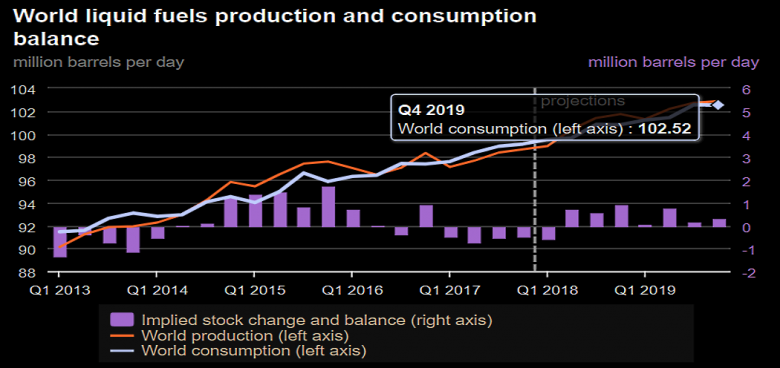
IEA: OIL NEED INVESTMENT

IEA - Oil production growth from the United States, Brazil, Canada and Norway can keep the world well supplied, more than meeting global oil demand growth through 2020, but more investment will be needed to boost output after that.
Over the next three years, gains from the United States alone will cover 80% of the world's demand growth, with Canada, Brazil and Norway – all IEA family members – able to cover the rest.
Despite falling costs, additional investment will be needed to spur supply growth after 2020. The oil industry has yet to recover from an unprecedented two-year drop in investment in 2015-2016, and the IEA sees little-to-no increase in upstream spending outside of the United States in 2017 and 2018.
"The United States is set to put its stamp on global oil markets for the next five years," said Dr. Fatih Birol, the IEA's Executive Director. "But as we've highlighted repeatedly, the weak global investment picture remains a source of concern. More investments will be needed to make up for declining oil fields – the world needs to replace 3 mb/d of declines each year, the equivalent of the North Sea – while also meeting robust demand growth."
Boosted by economic growth in Asia and a resurgent petrochemicals industry in the United States, global oil demand will increase by 6.9 mb/d by 2023 to 104.7 mb/d. China remains the main engine of demand growth, but more stringent policies to curb air pollution will slow growth. The increasing penetration of electric buses and LNG trucks will have a bigger impact on curbing consumption of transport fuels than the electrification of passenger vehicles.
In the United States, fuel-economy standards for passenger cars will curb gasoline demand with growth coming from the petrochemical sector, which is thriving thanks to low-cost ethane. New global petrochemicals capacity will account for 25% of oil-demand growth by 2023. Meanwhile, a new marine fuel rule with lower sulfur content that will come into force in 2020 is creating uncertainty in the market.
Global oil production capacity is forecast to grow by 6.4 mb/d to reach 107 mb/d by 2023. Thanks to the shale revolution, the United States leads the picture, with total liquids production reaching nearly 17 mb/d in 2023, up from 13.2 mb/d in 2017. Growth is led by the Permian Basin, where output is expected to double by 2023.
The path is clear to get those additional barrels to world markets. As a result of new investments in pipelines and other infrastructure that ease the current bottlenecks, US crude export capacity reaches nearly 5 mb/d by 2020 and Corpus Christi solidifies its position as the primary North American crude-oil outlet.
Virtually all of the OPEC output growth comes from the Middle East. In Venezuela, oil production has fallen by more than half in the past 20 years, and declines are set to accelerate. Sharply falling production in Venezuela will offset gains in Iraq, resulting in OPEC crude oil capacity growth of just 750,000 barrels a day by 2023. Unless there is a change to the fundamentals, the effective global spare capacity cushion will fall to only 2.2% of demand by 2023, the lowest number since 2007.
-----
Earlier:

2018, February, 16, 23:35:00
ФУНДАМЕНТАЛЬНЫЕ ПРЕОБРАЗОВАНИЯ РЫНКАМИНЭНЕРГО РОССИИ - Александр Новак поделился своим видением будущего углеводородной энергетики: «Она обладает огромным потенциалом цифровизации своих процессов, гибкой подстройки под нужды потребителей. Доля углеводородов, безусловно, будет снижаться, но с учетом роста населения, автопарка, спроса на энергию, абсолютное потребление продолжит расти. Если мы хотим надежно обеспечить мир энергией, нам придется найти разумный баланс между традиционной и новой энергетикой».
|

2018, February, 14, 10:05:00
IEA: OIL DEMAND GROWTH 1.6 MBDIEA - Our demand growth estimate for 2017 remains strong at 1.6 mb/d, reinforced by November data for the US. For 2018, the more positive global economic picture published by the International Monetary Fund is a key factor in raising our growth outlook to 1.4 mb/d. It was thought that the significant increase in the dollar price of crude oil since the middle of 2017 would dampen growth, and this might be the case to some extent, but the impact of higher prices has been partly offset in some countries by currency appreciations.
|

2018, February, 5, 07:45:00
EXXON ENERGY OUTLOOK - 2040EXXONMOBIL - Despite efficiency gains, global energy demand will likely increase nearly 25 percent. Nearly all growth will be in non-OECD countries (e.g. China, India), where demand will likely increase about 40 percent, or about the same amount of energy used in the Americas today.
|

2018, January, 29, 08:40:00
U.S. PETROLEUM DELIVERIES: 20.7 MBDAPI - Total petroleum deliveries in December rose to 20.7 million barrels per day. This was the strongest December monthly demand in the last decade.
|

2018, January, 26, 12:35:00
СПРОС НА НЕФТЬ: 100 МЛН.МИНЭНЕРГО РОССИИ - «На сегодня 100 млн баррелей в сутки - общемировой спрос на нефть, а сланцевая нефть- это всего 5,7 млн барр в сутки. Это лишь один из способов удовлетворения спроса рынка».
|

2018, January, 19, 12:30:00
U.S. FOSSIL FUELS WILL UPEIA - EIA forecasts that total fossil fuels production in the United States will average almost 73 quadrillion British thermal units (Btu) in 2018, the highest level of production on record. EIA expects total fossil fuel production to then set another record in 2019, with production forecast to rise to 75 quadrillion Btu.
|

2018, January, 12, 13:00:00
ТРАНСФОРМАЦИЯ МИРОВОГО РЫНКАМИНЭНЕРГО РОССИИ - На энергетическом рынке происходят существенные трансформации, появляются новые технологии, что в итоге приводит к изменению энергобаланса. В частности, за последние 10 лет добыча газа в мире выросла на 20% -- до 580 млрд м3, его доля в энергобалансе расширилась с 21 до 22%. При этом мировая торговля газом за тот же период увеличилась на 42%, или на 313 млрд м3. |





